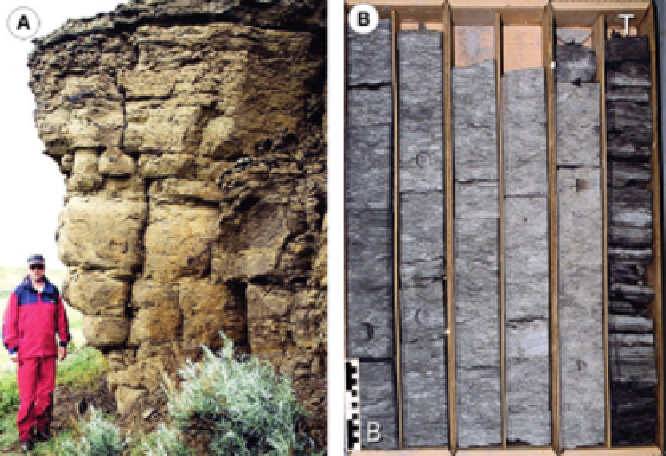Environmental Engineering Reference
In-Depth Information
FIGURE 13
Weakly storm-affected shoreface successions, typified by intense bioturbation.
(A) Crudely bedded, bioturbatedmuddy sandstone passing into burrowed silty sandstone of the lower
shoreface and middle shoreface, respectively, Fall River Formation, Montana. (B) Core boxes with a
thoroughly bioturbated succession, showing pervasively bioturbated (BI
¼
5) sandymudstones of the
upper offshore, grading into bioturbated (BI
¼
5) muddy sandstones of the lower shoreface and into
intensely bioturbated (BI
¼
4-5) silty sandstones of the middle shoreface. A marine flooding surface
(black arrow) is overlainbyburrowed sandymudstones and thin tempestites of the upper offshore. The
interval preserves only a single tempestite near the base of the fourth column from the bottom of the
interval. Scale bar
¼
15 cm.
horizontal burrows (
Dashtgard et al., 2009
). First, sedimentary structures pro-
duced by shoaling waves, breakers and surf, and swash-backwash are inter-
bedded across much of the TMS depositional profile, as a result of the
lateral shift of wave zones during the tidal cycle (
Fig. 15
). With increasing
storm-wave influence on TMS, sedimentary structures produced by storm
waves (i.e., HCS and SCS) are increasingly dominant throughout the lower
and upper shoreface (
Ainsworth et al., 2008
). Second, as a result of the regular
lateral shifting of wave zones, the sedimentological and ichnological criteria
(
Ob
), and passes into pervasively bioturbated (BI
¼
5) sandstone of the proximal lower shoreface.
(B) Box cores with a laminated-to-burrowed sandstone succession, consisting of bioturbated
(BI
¼
5) muddy sandstones interstratified with decimeter-scale HCS sandstones, passing into less
thoroughly burrowed (BI
¼
3-4) silty sandstones interbedded with thicker HCS sandstones. Interval
is interpreted to reflect lower shoreface deposits passing into middle shoreface units. Scale
bar
¼
15 cm. (C) Close-up photo of burrowed (BI
¼
5) lower shoreface silty sandstone with
Rosselia
(
R
),
Chondrites
(
Ch
), and
Skolithos
(
S
), erosionally overlain by wavy parallel-laminated sandstone,
interpreted as a tempestite.











Search WWH ::

Custom Search